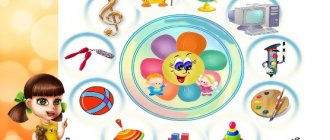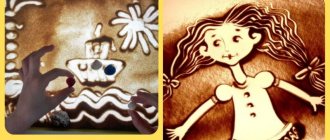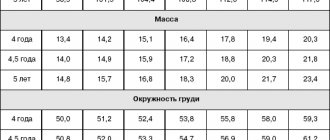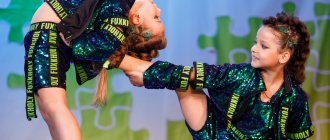Summary of an open lesson in preparatory group No. 2 “Ball School”
Main goals:
1) Improving the technique of dribbling the ball with the left and right hands in place and in motion, improving rolling the ball, strengthening throws of the ball from the chest into the basketball basket.
2) Learning to pass the ball from below and hitting the floor.
3) Develop attention, motor response, spatial orientation in game exercises with a ball.
4) Help strengthen major muscle groups.
5) Develop and cultivate interest in physical education, the desire to engage in sports and physical education independently.
6) Create a positive emotional and psychological atmosphere.
Goal: to teach children to pass the ball from the chest and hit the floor.
Equipment : basketballs according to the number of children, cones according to the number of children, multi-colored small balls according to the number of children, basketball backboard, jump ropes, music speaker, whistle, hoops according to the number of children.
Venue for open classes : gym.
Lesson time : 30 minutes. From 10:45 to 11:15.
Lesson summary:
Progress of the lesson.
| Parts of the lesson | Content | Dosage | Guidelines |
| Introductory part | Children enter the gym to the sound of a football march. Teacher: Hello guys! We have guests today, they want to see how you are doing. Let's say hello to them. "Be equal!" “Attention!” Calculation in order. Teacher: — Follow the guide through the hall with a march!
Walking while restoring breathing. Form a column of three. (When changing lanes, children take their own basketballs.) | 7 min. | |
| Main part | O.R.U. with basketballs: 1. I.p. feet shoulder-width apart, ball in hands. Tilts the head left and right, turns the head left and right 2. I.p. feet shoulder-width apart, ball in hands. Rolling the ball with the palms of the hands. 3. I.p. feet shoulder-width apart, ball in hands. Raises the ball forward and upward. 4. I.p. feet shoulder-width apart, ball in hands. Dribbling the ball with the left and right hands in place and with turns to the left and right side 360 degrees, hitting the ball on the floor with both hands and catching the ball, throwing the ball up, clapping and catching; hitting the ball on the floor with one hand and catching it with the other. 5. I.p. feet shoulder-width apart, ball in hands. Throwing the ball up and catching it with the addition of clapping the hands. 6. I.p. feet together, ball in hands. Tilts towards the feet. 7. I.p. feet shoulder-width apart, ball overhead. Counting squats. 8. I.p. The ball is on the floor, hands on the belt. Rolling the ball with the left and right foot “heel-toe”. 9. I.p. feet shoulder-width apart, ball on the floor. Passes on the spot with the left and right leg, with the inner part of the foot. 10. I.p. sitting down, fixing the ball with your feet, hands in support behind you. Exercise "corner". 11. I.p. sitting down, fixing the ball with your feet, hands in support behind you. Rolling the ball with your feet. 12. I.p. feet shoulder-width apart, ball in hands. Breathing movements. Teacher: Right! In the column one at a time, step by step! O.V.D.: 1. Dribbling the ball with your left and right hands in a circle. 2. Dribbling the ball with your left hand and stopping the ball with one hand. 3. Dribbling the ball with your right hand and stopping the ball with one hand. 3. Rolling the ball with your left and right hands while bending forward 4. Changing into hoops. Work in pairs: a) passing the ball from bottom to top, b) passing the ball with a blow to the floor, c) the first numbers pass with a blow to the floor, and the second numbers from bottom to top, then change at the command of the physical education instructor, 5) Rebuilding in three columns. Collection of hoops. Dribbling the ball with your left and right hands to the line at the whistle signal, then from the line throwing the ball into the basketball hoop from the chest, picking up the ball and returning to your column, dribbling the ball with your left and right hands. 6) Outdoor game “Multi-colored balls” (the game is played to music). | 19 min. | Do the exercises carefully! Passing balls for accuracy. Do not hit the ball hard on the floor. When dribbling the ball, breathe through your nose. |
| Final part | Formation! Pay for “first - second”! We divide into two subgroups. Sedentary game: “A swan flew across the blue sky.” Construction. Drill teams: “Be equal!” “Attention!” | 4 min. |
MAGAZINE Preschooler.RF
Modified program “Ball School” (6 – 7 years old)Educational area: physical development.
Explanatory note
The additional educational program (ADP) “Ball School” was developed in accordance with: - Federal State Educational Standard for Education No. 1155 dated October 17, 2013; — Federal Law “On Education in the Russian Federation” No. 273 dated December 29, 2012; — UN Convention on the Rights of the Child; — Law of the Russian Federation “On hygienic requirements for the maximum load on preschool children in organized forms of education” ; — Order of the Ministry of Defense of the Russian Federation and the Ministry of Health of the Russian Federation “State Committee of the Russian Federation for Physical Culture and Sports No. 2715/227/166/19 dated July 16, 2002 “On improving the process of physical education in educational institutions of the Russian Federation . This program was written based on the program “Physical Education for Preschoolers” by L.I. Penzulaeva and elements of the “Ball School” by N.I. Nikolaeva. The program determines the content and organization of educational activities, ensures the development of the personality of preschool children in the development of motor qualities, the formation of elements of running, jumping, serving the ball, catching it, etc., the development of moral and volitional qualities and emotional state.
Relevance: Statistical data and facts from medical practice indicate that many children experience motor deficits, which lead to pronounced functional disorders in the body: a decrease in the strength and performance of skeletal muscles entails impaired posture, coordination of movements, endurance, flexibility and strength, flat feet, causing delays in age-related development. To satisfy children's need for physical activity in kindergarten, it is necessary to conduct additional physical development clubs. Activities with a ball occupy an important place in the system of physical education of preschool children. Exercises in throwing and rolling balls contribute to the development of the eye, coordination, dexterity, rhythm, coordination of movements, and improve spatial orientation. Exercises with a ball of various sizes develop not only large, but also small muscles, increase mobility in the joints of the fingers and hands, and increase blood circulation. They strengthen the muscles that support the spine and promote good posture. Therefore, working with a ball occupies one of the main places in physical education and health work with children.
Problem: Superficial interest of parents and children in ball games; deficit of movements in preschool children.
Goal: Involving preschool children and parents in active physical and sports activities. Enriching the motor experience of children 6-7 years of age
Tasks:
Wellness:
- preserve and strengthen the physical and mental development of children; - create conditions to satisfy children’s natural need for movement; — dose physical activity taking into account the health status of children and their functional capabilities.
Educational:
- to create accessible knowledge about the basics of a healthy lifestyle and introduce preschoolers to physical education; - to form in children basic knowledge and ideas about different types of movements and methods of performing them; - promote children’s mastery of gaming (basketball, volleyball, pioneer ball, football) activities; - learn to catch the ball with your hands, throw the ball from behind your head while standing, send it up, as well as hitting the ground, receive the ball from different positions, catch it with both hands, throw it over the net, throw the ball into the hoop, throw it long distance; — teach children to follow the basic rules of the game, coordinating the children’s actions with the text and music.
Educational:
- develop children's interest in outdoor games and physical exercises using different objects; - to develop in children the ability to play together, coordinating their actions with the actions of others; - encourage children to be independent and active in games and exercises.
Safety regulations:
- At the beginning of the lesson, you should do a warm-up, warm up your muscles and ligaments well.
- Inspect the playground to ensure there are no dangerous objects on it.
- It's good to pump up the ball.
- Do not receive the ball from above with straight arms, do not point your thumbs forward.
- When receiving the ball from below, do not bend your arms at the elbows.
- Be careful not to get the ball under your feet.
- After jumping, land on bent legs in a wide stance.
Form of training: specially organized classes; game exercises, group, subgroup and individual exercises to master the technique of playing with the ball.
Number of classes: 1 lesson per week, 4 lessons per month, 36 lessons per academic year (from 1 week of September to May). The result of children's activities can be physical education, holidays, and entertainment.
Implementation period: 1 year.
Form of summing up: 1. Diagnostic examination of children on mastering the program 2. Final lesson with the participation of parents of the game Pioneerball.
Organizational and methodological instructions for conducting exercises with the ball
Classes are designed for children 6-7 years old, the duration of classes is 30 minutes, they are held once a week in the gym or on the sports ground, they consist of 3 parts. Stages of mastering working with the ball: Stage 1 – preparatory. Its main task is to develop coordination of movements, the ability to see the ball and quickly react to its flight. To solve this problem, the following exercises are included:
- throwing the ball up onto the ground and catching it with both hands;
- throwing and catching the ball after clapping;
- throwing and catching the ball with one hand;
- throwing and catching the ball in motion;
- throwing and catching the ball from different positions and in different ways in pairs;
- throwing at horizontal and vertical targets;
- throwing the ball into the hoop;
- throwing the ball over a volleyball net;
- throwing the ball at a distance;
- Throwing a medicine ball with both hands (weight up to 1 kg) from the chest and from behind the head.
- stage – leading-up. His task is to guide the children’s movements. For this purpose, a child from the opposite line is asked not to catch the ball, but to hit it, throwing the ball to each other without a net. Batting (volleyball) occurs by pushing two palms in the desired direction. The distance between partners increases to 2 m or more.
- stage is the main one. Much attention is paid to playing volleyball (pioneerball) according to simplified rules; the task is to teach preschoolers to throw the ball and catch it, measuring the height, range and accuracy of the throw.
Working with parents:
- To give parents knowledge about what children should be able to do in handling the ball according to the program.
- Joint activities of children and parents, emotions from playing with a ball.
- Organization of the photo exhibition “Ball School”
Visual information for parents:
- Folder - moving on the topic: “My funny ringing ball” (contains the history of the ball, data on modern balls, recommendations for parents on choosing balls for children, the meaning of the ball for a child, a card index of Russian folk games with the ball, exercises with the ball, etc. )
- Folder on the topic: “Playing at home” (contains creative outdoor games for home, outdoors, with a ball, etc.)
- Folder on the topic: “Physical education is great” (contains outdoor games for the whole family, outdoor games of different nations, etc.)
- Replenishing the “Games on the Street”
Direct educational activities
Lesson 1 - 4. Getting to know the ball. (September)
Tasks:
- teach children to take balls from the basket and put them in place; - provide an opportunity to understand the physical qualities of the ball (elasticity, weight, volume)
Equipment: rubber balls according to the number of children, skittles, medicine balls.
Contents and methodology.
First part. 1. Walking one after another. Take the balls one by one from the basket. 2. Push the lying ball, catch up and lift it. All children perform the exercise at the same time (4-6 times). 3. Rolling the ball with one hand around objects. Line up children in 4-6 columns, place 4-6 stuffed balls or other objects opposite each column. Roll the ball with your left and right hands, bending over.
Second part.
1. Game “Toss - catch” . All children throw balls as high as possible and catch them. You can catch after the ball bounces off the floor or on the fly. 2. Hitting the ball on the ground and catching it with both hands.
The third part. Game "Knock down the pin" . Children stand on a line, 2-3 m from which there are 3-4 pins. The ball can be rolled or thrown in any way. The task is completed by 3-4 children at the same time (3 minutes). Low mobility relay game “Don’t drop the ball” . Children form two circles. One of the children in each circle has a ball in their hands, they are the drivers. At the instructor's signal, the children begin to quickly pass the ball around. Having received the ball back, the driver raises the ball up. The team whose ball circles the fastest is the winner.
Lesson 5 – 8. (October)
Tasks:
- teach children to throw the ball up onto the ground and catch it with both hands; - learn to throw the ball over a volleyball net; - cultivate friendly relationships between children.
Equipment: medium-sized balls for the number of children, volleyball net.
Contents and methodology
First part. Fun workout
1. Walking in a column, one at a time, on toes, arms up. Walking on your heels, hands behind your head. Walking: one foot on the heel, the other on the toe. Run. Side gallop with right and left sides. Walking "Crayfish" . Run backwards. Walking Bear Cubs. Normal walking.
Second part. 1. Throw the ball up and catch it with both hands. We remind children that the ball should fly straight up and that they need to watch its flight. You need to catch the ball with both hands and not press it to your chest (12-15 times in a row). 2. Throw the ball on the floor and catch it with both hands. Calculate the force of the throw (10-12 times). 3. Throw the ball over a net stretched above the child’s head (6-8 times). 5-6 people stand on both sides of the net. Children standing on one side of the net have balls in their hands. The instructor gives instructions on how to throw the ball (from below, from the chest, from behind the head). The guys throw the ball over the net to their partners using the indicated method. Children standing on the other side catch the ball and throw it back (always in the same way).
The third part. Low mobility game “Don’t drop the ball” . Children form two circles. One of the children in each circle has a ball in their hands, they are the drivers. At the instructor's signal, the children begin to quickly pass the ball around in a circle. Having received the ball back, the driver raises the ball up. The team whose ball circles the fastest is the winner.
Lesson 9-12 (November)
Tasks:
- learn to throw and catch the ball with one hand, throw it into the hoop;
- consolidate the ability to throw and catch the ball from different positions and in different ways in pairs, throw the ball over the net;
- cultivate endurance and attention.
Equipment: rubber balls according to the number of children, whistle.
Contents and methodology.
First part. Varieties of walking (on toes, with different positions of the hands; on heels, back forward; in a half-squat; heels together, toes apart; toes together, heels apart). Walking on all fours ( “Crayfish” , “Elephants” ). Varieties of running (with sweeping the shin back; gallop: right and left side; with high knees, with straight legs).
Second part. 1st – 2nd week is performed frontally 10 times. 1. Tossing and catching the ball with one hand. 2. Throwing the ball into a basketball hoop from a standing position. 3. Dribbling the ball and throwing into the hoop. Rearranging children into pairs. 4. Throwing the ball to each other in pairs in different ways, without letting the ball fall to the floor. 3rd – 4th week. 1. Throw into the ring while jumping up. 2. Throw into the hoop with one hand. 3. Throwing the ball to each other in pairs and hitting the ball on the floor. Hands with the ball up. Hit the ball hard onto the floor. Try to ensure that only the hands work, and the arms themselves remain at the top. 4. Throwing the ball over the net with one or two hands.
The third part. Sedentary game “Be attentive” (3-4 min). Children stand in a circle, with the leader (teacher) in the middle. The presenter throws the ball to someone from the circle, using deceptive actions, and he must catch the ball. Anyone who does not catch the ball receives a penalty point. Remind children how to receive the ball. Calculate the force of the throw. If the ball goes over, take a step back and catch it. If the ball doesn't reach, take a step forward and catch it. If the ball flies to the side, take a step to the side and catch it.
Lesson 13-16 (December)
Tasks:
- learn to throw the ball to each other in pairs (from below, from the chest, from behind the head; throwing on the floor, catching the ball after the rebound; passing from the chest while moving at a side gallop);
- continue to teach how to throw the ball over the volleyball net and jump up;
- foster friendly relationships between children.
Equipment: balls according to the number of children, net, whistle, jump ropes according to the number of children.
Contents and methodology.
First part. 1. Walking on toes, arms to the sides. Walking on your heels, hands behind your head. Jumps. Walking in a half-squat, arms up. Running with a change of direction. Walking with a cross step: sideways. Running with straight legs forward. Walking "Crayfish" . Running with the shin whipping backwards. Walking: heels together, toes apart. Fast run (2 laps). Walking "Bear Cubs" . Normal walking.
Second part. 1st – 2nd week. Children stand in pairs and perform exercises 10 times. 1. Throwing and catching the ball after clapping. 2. Throw each other from below. 3. Throw each other from behind the head. 4. Chest throw to each other. 5. Throwing the floor, catching the ball after the rebound. 6. Side gallop in pairs, passing the ball to each other from the chest. 3rd – 4th week. 1. Throw the ball in pairs through the volleyball net. 2. Jumping up near the net, pushing off with both feet, trying to reach the top edge of the net with your hands (2 sets of 10 jumps in a row with rest between sets). 3. Throwing the ball with one hand over a distance through the net.
The third part. Sedentary game "Unusual Artist" . Each child has a jump rope in his hands. At a signal, children place a figure from a jump rope on the floor. The teacher determines the winner.
Lesson 17-20 (January)
Tasks:
- improve throwing and catching the ball with both hands, throwing the ball over the volleyball net; — continue to teach passing the ball from the chest while moving at a side gallop and throwing the ball into the hoop.
Equipment: balls according to the number of children, a net, small balls according to the number of children, 5-6 different items for the game.
Contents and methodology.
First part. Walking on toes. Walk on your heels, back forward, hands to your shoulders. Run backwards. Walking "Spiders" . Running with the shin whipping backwards. Running with straight legs forward. Walking: toes together, heels apart. Jumping on two legs while moving forward. Walking: one foot on the heel, the other on the toe. Gallop: right and left side. Walking "Crayfish" . Run, changing the direction of movement at the instructor’s signal. Normal walking.
Second part. 1st – 2nd week children perform exercises frontally 10 times. 1. Throw the ball up with one hand, catch with both hands. 2. Throwing on the floor with one hand, catching with both. 3. Throwing the ball into the hoop. 3rd – 4th week children perform exercises in pairs. 1. Throwing and catching the ball in motion in pairs. 2. Throwing the ball over a volleyball net in different ways.
The third part. Sedentary game "Hit the ball" . Children stand in a circle. There is a ball in the middle of the circle. After the teacher's instructions, one child closes his eyes. He goes to the ball and tries to kick the ball. The ball should be hit in such a way as not to hit the children standing opposite.
Lesson 21 – 24 (February).
Tasks:
- improve work with the ball, measuring the height, range and accuracy of the throw; - continue to learn how to throw the ball over the volleyball net; - learn to play volleyball without serving; – promote the development of eye, coordination and dexterity
Equipment: balls according to the number of children, net, whistle.
Contents and methodology.
First part. 1. Walking in a column, one at a time, on toes, arms up. Walking on your heels, hands behind your head. Walking: one foot on the heel, the other on the toe. Run. Side gallop with right and left sides. Walking "Crayfish" . Run backwards. Walking Bear Cubs. Normal walking.
Second part. 1st – 2nd week perform exercises in pairs 10 times. 1. Throwing and catching the ball with one hand in pairs (1.5 m). 2. Throwing and catching the ball while kneeling in different ways. 3rd – 4th week. 1. Pairs of players throw the ball through a volleyball net. 2. Learning to play volleyball without serving.
The third part. Low mobility game “Forward with the ball” . Sit on the floor, hold the ball between your feet, and rest your hands on the floor behind you. Move forward with the ball, without releasing the ball, to a distance of approximately 3 m.
Lesson 25-28 (March). Tasks:
— teach children not to catch the ball, but to hit it; - repeat exercises with the ball in motion; - practice serving by throwing the ball with one hand over the net; - learn to play volleyball.
Equipment: balls according to the number of children, nets, sandbags according to the number of children.
Contents and methodology.
First part. A fun workout. Walking on toes, arms to the sides. Walking on your heels, hands on your waist. Easy running. Walking in a half-squat, hands behind your head. Side gallop with right and left sides. Walking: one foot on the heel, the other on the toe. Running with high knees. Walking "Bear Cubs" . Running with the shin whipping backwards. Walking with side steps. Jumping on the left - right leg. Walking "Crayfish". Running with straight legs forward. Normal walking.
Second part. 1st-2nd week children perform exercises frontally 10 times. 1. Throwing the ball up and catching it in a circle. 2. Throwing the ball on the ground and catching it in a circle. 3. Throwing at a vertical target. 4. Learning to play volleyball without serving. 3rd – 4th week children work in pairs. 1. Work with the ball in pairs. (It is suggested not to catch the ball, but to hit it with a push of two palms from above in the desired direction). 2. Throwing the ball at a distance with one hand from above through the net (practicing the serve). 3. Learning to play volleyball with serve.
The third part. Game "Don't drop the bag" . Children stand on one leg, bend the other at the knee and place a bag on their knee. They try to stand without losing their balance. The bags are placed on the knee at the instructor’s signal.
Lesson 29 – 32 (April).
Objectives: - continue to teach children to catch the ball with both hands; - serve by throwing the ball with one hand over the net; - teach how to play pioneer ball.
Equipment: balls according to the number of children, volleyball net, whistle.
Contents and methodology.
First part. A fun workout. 1. Walking on your toes, arms up. Walking on your heels, hands on your waist. Easy running. Walking "Spiders" . Jumping on two legs. Walking with a cross step forward. Running with high knees. Walking "bear cubs" . Running with the shin whipping backwards. Walking with side steps. Walking "Crayfish" . Running with straight legs forward. Normal walking.
Second part. Game "Pioneerball" . Each team consists of five players on the court and several substitutes. The teacher monitors compliance with the rules of the game: gives signals when players violate the rules, counts goals thrown to opponents, resolves controversial goals, and controls the time of the game. The game consists of two five-minute halves, with a five-minute break between them. During the break and at the end of the game, a sedentary game with a ball is played (lasting 3 - 4 minutes): the game “Make a figure” , “Be careful” . When the ball hits the opponents' side, the team is awarded 2 points. The game may end in a victory for one of the teams or a draw.
The third part. Normal walking.
Lesson 33 – 36 (May).
Game "Football" .
The goal of the game is to throw as many balls as possible into the opponent’s goal, and after losing the ball, defend your own, while observing the rules of the game. Equipment: soccer ball, goal (2), whistle, player badges to wear on the front and back of their jerseys.
Progress of the game.
First part. A fun workout. Walking on toes. Walk on your heels, back forward, hands to your shoulders. Run backwards. Walking "Spiders" . Running with the shin whipping backwards. Running with straight legs forward. Walking: toes together, heels apart. Jumping on two legs while moving forward. Walking: one foot on the heel, the other on the toe. Gallop: right and left side. Walking "Crayfish" . Run, changing the direction of movement at the instructor’s signal. Normal walking.
Second part. A game. Each team consists of 5-8 children and several reserves. The game lasts 30 minutes. The game time is divided into two halves of 15 minutes each with a five-minute break. At the end of the game, a sedentary game is played (lasting 3–5 minutes) in order to bring the child’s body into a calmer state. Sedentary game "Hit the ball" . Players have the right to dribble the ball with their feet, pass it with their feet to a teammate, and score the ball into the goal. The task of the players of the opposing team is not to let the enemy get to their goal and not to allow the ball to be scored.
The third part. Normal walking.
Used Books:
- Adashkyavichene E.J. “Basketball for preschoolers” : From work experience - M.: Education, 1983
- Vorotilkina I.M. “Physical and recreational work in preschool educational institutions” - publishing house NC ENAS, 2004
- Nikolaeva N.I. “Ball School” - publishing house “Childhood-Press” , 2008.
- Sochevanova E.A. “Outdoor games with running for children 4-7 years old” - “Childhood-press” , 2009.
- Filippova S.O., ed. “Companion to the head of physical education of a preschool institution” - “Childhood-press” , 2005.
- Khabarova T.V. “Development of motor abilities of older preschool children” - publishing house “Childhood-Press” , 2010
- Anisimova T.G. and Savinova E.B. “Physical development of children 5-7 years old” Publishing house “Teacher” , 2009
| Next > |






